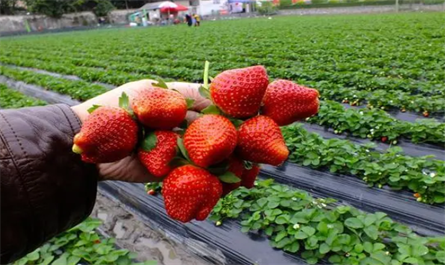Application of plant growth hormone on Strawberry planting

1. Fruit expansion and yield increase
Naphthalene acetic acid (NAA)
Spraying young fruits with 10-50 mg/L naphthalene acetic acid solution can promote fruit enlargement and increase yield.
2,4-D
Spraying young fruits with 10-50mg/L 2,4-D solution can promote fruit enlargement and increase yield.
Indole-3-acetic acid (IAA)
Spraying 10-50mg/L Indole-3-acetic acid solution on young fruits can promote fruit enlargement and increase yield.
3-indolebutyric acid (IBA)
Spraying young fruits with 10-50mg/L 3-indolebutyric acid (IBA) solution can promote fruit enlargement and increase yield.
2. Retain freshness
Cytokinin
After harvesting strawberries, spray or soak the fruits with 10mg/L Cytokinin. After slightly dry, put them in shallow boxes, 200-500g per box. This can keep the strawberry fruits fresh and extend the storage and supply period.
3. Promote growth, improve quality, and increase production
Compound Sodium Nitrophenolates (Atonik)
Soak strawberry seeds with Compound Sodium Nitrophenolates (Atonik) 6mg/L liquid for 3-5 hours before sowing.
After drying in the shade, sow seeds to promote germination and rooting. During seedling cultivation, spray Compound Sodium,Nitrophenolates (Atonik) 6mg/L liquid every 5-7 days. Spray 2-3 times in total to develop healthy seedlings.
After planting, add urea 0.1%-0.3% to Compound Sodium Nitrophenolates (Atonik) 6mg/L. Spray the leaves or root irrigation once every 5-7 days to extend the harvest period and increase the sugar content.
Brassinolide(BR)
Spraying with 0.01-0.1 mg/L liquid can increase the chlorophyll content of leaves, increase the net photosynthetic rate of leaves, increase sugar content, vitamin C content, single fruit weight, reduce acid content, and make the fruit brightly colored. At the same time, the fruit can be ripe earlier and put on the market earlier, thereby improving economic benefits.
Triacontanol (TRIA)
Spraying 0.5mg/LTriacontanol (TRIA) liquid during the greening stage and first flowering stage of strawberries can increase the chlorophyll content, improve the efficiency of light energy utilization in the leaves, and increase the yield.
Gibberellic Acid GA3
strawberries can promote the formation of flower buds under low temperature and short daylight conditions.However, when strawberries are cultivated under protective facilities, or because the temperature during planting is too high and cannot meet the normal low temperature requirements, the plant growth will be dwarfed and the flower buds will differentiate,Reduced flowering and fruiting.
DA-6 (Diethyl aminoethyl hexanoate)
For growing strawberries, if 10 mg/L of DA-6 (Diethyl aminoethyl hexanoate) can be spray 4 times continuously from the flowering stage to the fruit development stage, the production and income can be continuously increased, and the fruit will be shiny. Good quality, high authenticity rate, less deformed fruits, high sugar content, and low rottenness rate; the benefits for transplanted seedlings are stable root bending, new root growth, promotion of new leaf development, and improved cold resistance. In addition, spraying 10mg/L on green seedlings and transplanted seedlings is beneficial to greening and survival.
4. Increase fruit setting rate and reduce deformed fruits
Daminozide
In late autumn and early winter, spraying 1000-2000mg/Ldaminozide solution on the plants can effectively prevent cold and frost, without adverse effects on the future growth of the plants. In addition, if the strawberry grows too vigorously during the harvest period, you can also spray 1000-2000mg/Ldaminozide solution once to adjust the balance between vegetative growth and fruiting, which can increase the fruit setting rate by 71.2% and at the same time improve the cold resistance of the plant.
Naphthalene acetic acid(NAA)
During the early flowering stage, full flowering stage and fruiting stage of strawberry, 50-150mg/L Naphthalene acetic acid (NAA) solution is poured into the center of the flower. Each plant uses a syringe without a needle to spray 5mL on the inflorescence and growth point. When 0.3% boric acid was sprayed on the leaves 10 days before flowering, the deformed fruit rate dropped from 25.26% in the control to 9.92%-15.25%. Among them, 100 mg/L Naphthalene acetic acid (NAA) 0.3% boric acid was the best, and the deformed fruit rate was lower than the control 60.73%.
RECENT POSTS
Featured News



